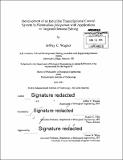Development of an inducible transcriptional control system in plasmodium falciparum with applications to targeted genome editing
Author(s)
Wagner, Jeffrey C. (Jeffrey Charles)
DownloadFull printable version (10.49Mb)
Other Contributors
Massachusetts Institute of Technology. Department of Biological Engineering.
Advisor
Jacquin C. Niles.
Terms of use
Metadata
Show full item recordAbstract
Malaria accounts for over 500,000 deaths each year. While malaria is caused by multiple distinct parasites of the genus Plasmodium, P. falciparum is responsible for the majority of morbidity and mortality due to the disease. Despite this fact, molecular tools for genetic experimentation in the parasite remain underdeveloped. In particular, the ability to inducibly control gene expression and edit the genome in a site-specific manner present significant challenges. In addition, the building of genetic constructs poses challenges due to the required vector size and the high A+T richness of the P. falciparum genetic regulatory elements. This work begins by presenting the first vector family for use in the parasite made up of modular parts and encompassing all selectable markers and replication technologies in current use. It also discusses the development of a 2A like viral peptide tag for use in expression of multiple differentially localizing proteins from a single expression cassette. Based on this work, we were then able to construct vectors to reconstitute the T7 RNA polymerase expression system in P. falciparum, functionally creating the first system for directed expression of non-coding RNA in the parasite. We were then able to use this expression system to adapt a clustered regularly interspaced short palindromic repeats (CRISPR)/Cas9 system in the parasite and use it to achieve genome editing at high efficiency at multiple loci. The data imply an adaptable system to readily edit the genome of the parasite and holds promise for the ability to create gene knockouts, perform allelic replacements, and add regulatory elements into the parasite significantly faster than has been previously demonstrated. This also represents the first illustration of the functionality of a CRISPR/Cas9 system in any non-bacterial pathogenic organism. In addition, we were able to introduce the lac repression system in order to regulate the T7 RNA polymerase dependent production of RNA and have created the first inducible expression system for RNA in any apicomplexan parasite. This work provides several new molecular tools and frameworks to aid in the study of, and fight against, malaria.
Description
Thesis: Ph. D., Massachusetts Institute of Technology, Department of Biological Engineering, 2014. Cataloged from PDF version of thesis. Includes bibliographical references (pages 112-119).
Date issued
2014Department
Massachusetts Institute of Technology. Department of Biological EngineeringPublisher
Massachusetts Institute of Technology
Keywords
Biological Engineering.